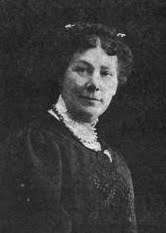Dora Montefiore

Dorothy (Dora) Frances Montefiore (née Fuller) (20 December 1851 – 21 December[1] 1933) was an English-Australian women's suffragist, socialist, poet, and autobiographer.
Early life
Montefiore was born at Kenley Manor near Coulsdon, Surrey, daughter of Francis and Mary Ann Fuller. Her father was involved with railway engineering and was a driving force behind the Great Exhibition. Her Mother was a daughter of George Drew, a property speculator who developed Caterham. She was educated by governesses and tutors and at Mrs Creswell's school at Brighton. In 1874, she went to Sydney to assist her brother's wife. She returned briefly to England, and on her return to Sydney married Jewish merchant George Barrow Montefiore, son of Joseph Barrow Montefiore. They had two children.
In 1889, her husband was lost at sea. When she learned that she had no automatic right to guardianship of her children, she became an advocate of women's rights.[2] The first meeting of the Womanhood Suffrage League of New South Wales was held at her home on 29 March 1891. In 1892 she left Australia and after spending several years in Paris, settled in England.
Suffragette
In 1898, Montefiore produced a book of verse Singings Through the Dark. She also continued to be active in the suffrage movement, serving on the executive of Millicent Fawcett's National Union of Women's Suffrage Societies and she joined the Women's Social and Political Union that had been formed by Emmeline and Christabel Pankhurst. In 1897, she proposed the formation of the Women's Tax Resistance League. In 1906, to protest lack of political representation, she refused to pay her taxes and remained barricaded in her home for six weeks. The League used this occasion as an opportunity for demonstrations and publicity:[3]
The house, surrounded by a wall, could be reached only through an arched doorway, which Montefiore and her maid barred against the bailiffs. For six weeks, Montefiore resisted payment of her taxes, addressing the frequent crowds through the upper windows of the house.[4]
In October of the same year, Adela Pankhurst, Dora and others were arrested for demanding votes for women in the lobby of the House of Commons. She also joined several socialist organisations around this time, including the Women's Freedom League, the Social Democratic Federation and the British Socialist Party.
Dora was friends with suffragette Adelaide Knight[5] and Minnie Baldock. Montefiore was one of the speaker's at Baldock's Canning Town WSPU group.[6]
Later life
She returned to Australia in 1910 to visit her son Gilbert. While in Australia, she edited International Socialist Review of Australasia when its owner Henry Holland fell ill in 1911. She also met William Arthur Holman.
In October 1913, she was involved in a plan to take children from Dublin where strikes had reduced food supplies, to Britain so that the children would not suffer while the strikes continued. Archbishop of Dublin William Joseph Walsh, wrote a public letter condemning the plan.[7] Those involved were arrested and charged with kidnapping. The charges were later dropped.
During the First World War, she joined the British Socialist Party, and in 1920, was elected to the provisional council of its successor, the Communist Party of Great Britain. When her son died in 1921 following his service in the War, the Australian government would not allow her to visit Australia until Holman spoke on her behalf and assured them that she promised not to engage in communist propaganda.[2] She was allowed to visit, and also used the time to make connections in the Australian communist movement, meeting Christian Jollie Smith. She represented the Communist Party of Australia in Moscow in 1924.
She wrote her autobiography in 1927; it was called From a Victorian to a Modern. She died at Hastings in 1933.
Posthumous recognition
Her name and picture (and those of 58 other women's suffrage supporters) are on the plinth of the statue of Millicent Fawcett in Parliament Square, London, unveiled in 2018.[8][9][10]
See also
References
- ↑ http://adb.anu.edu.au/biography/montefiore-dorothy-frances-dora-7626
- 1 2 Allen, J. Dorothy Frances (Dora) (1851–1933), Australian Dictionary of Biography, Volume 10, Melbourne University Press, 1986, pp 556–557.
- ↑ Gross, David M. (2014). 99 Tactics of Successful Tax Resistance Campaigns. Picket Line Press. pp. 44, 94, 189. ISBN 978-1490572741.
- ↑ Nym Mayhall, Laura E. The Militant Suffrage Movement: Citizenship and Resistance in Britain, 1860–1930
- ↑ Adelaide Knight, leader of the first east London suffragettes — East End Women's Museum
- ↑ http://spartacus-educational.com/WbaldockM.htm
- ↑ "Archbishop Walsh on the 'Save the Kiddies' Campaign." Archived 4 August 2012 at Archive.is
- ↑ "Historic statue of suffragist leader Millicent Fawcett unveiled in Parliament Square". Gov.uk. 24 April 2018. Retrieved 24 April 2018.
- ↑ Topping, Alexandra (24 April 2018). "First statue of a woman in Parliament Square unveiled". The Guardian. Retrieved 24 April 2018.
- ↑ "Millicent Fawcett statue unveiling: the women and men whose names will be on the plinth". iNews. Retrieved 2018-04-25.
External links